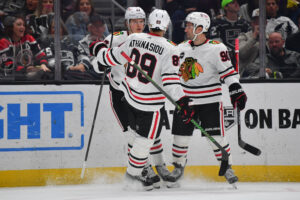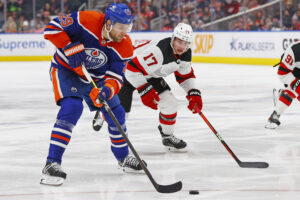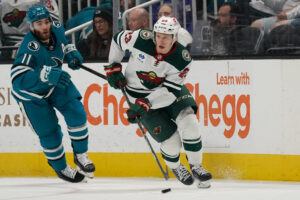Montreal Canadiens general manager Marc Bergevin has made decisions that have divided Habs fans. Rumblings about Bergevin’s management style existed before the now infamous P.K. Subban for Shea Weber trade. However, for many, June 29, 2016, was a day that broke many Canadiens fans. It left them angry, sad and confused about the direction of their beloved franchise.
It also split the fanbase. While many were shocked, others were empowered. Those who had been critical of Subban now mocked fans who disliked the trade. Fans who were angry were called second class fans. For some, loyalty to the team, right or wrong, is all that matters. They say time heals all wounds. However, in Habsland, this is not the case. The trade split the fans and divided the media. It may have broken the team.
A little over a year after that day in June, many are wondering how much time does Marc Bergevin have left as Canadiens GM?
The Last Stand of Marc Bergevin
To judge a general manager on a single trade is nonsensical. Teams aren’t built through a single transaction. It takes years of careful planning and maneuvering. In hockey, teams and GM’s tend to work on a five-year cycle. It gives the GM (supposedly) enough time to construct a winning team. Marc Bergevin is entering his sixth season as Canadiens general manager, so for better or worse this team is his.
Optimistic Hire
Marc Bergevin was hired in May of 2012. Coming to Montreal from the very successful Chicago Blackhawks, many fans were optimistic about the hire. The Habs were coming off a disastrous 2011-12 season that saw them finish 15th in the conference. Bergevin said all the right things at his press conference. He wanted to build through the draft. The Canadiens were going to make a concerted effort to scout the QMJHL to avoid letting local stars slip through their fingers. He did a good job of trying to manage expectations for the team that finished 15th in the east. Fans and media alike approved of the hire.
After filling much of his management team, Bergevin made his first questionable decision. The Canadiens were looking for a new head coach after Jacques Martin was fired during the 2011-12 season. Because of a team-imposed rule, the Habs head coach needed to be bilingual. This significantly cut down the number of candidates available to the Habs. Still, Marc Bergevin shocked many when he named Michel Therrien as the next head coach of the Canadiens. At the time of his hire, Therrien was working as a TV analyst covering the Canadiens. He had not coached since being fired from the Pittsburgh Penguins in 2009. Still, the franchise seemed to be trending up.
Early Success
The consolation prize for such a poor season in 2011-12 was the third overall pick in the NHL entry draft. The Canadiens used the pick to select Alex Galchenyuk of the Sarnia Sting. Galchenyuk was touted to be the Canadiens future number one centre, a weakness on the Canadiens since 1997.
Bergevin made it known he wanted the Canadiens to be difficult to play against. So he signed Brandon Prust and Colby Armstrong in free agency. Unfortunately for hockey fans everywhere, the NHL season was delayed because of a lockout. A compressed 48-game schedule was created only after the league and NHLPA agreed on a Collective Bargaining Agreement (CBA).
The Habs took advantage of the compressed schedule to win the Atlantic division and make the playoffs. Bergevin looked very shrewd in his dealings. Gone were the big money mistakes of past GM’s. First, he bought out Scott Gomez and Tomas Kaberle. Then he traded Erik Cole to Dallas for Michael Ryder. Adding to the excitement was the success of a couple of rookies, Alex Galchenyuk and Brendan Gallagher. Galchenyuk made the team but was playing on the wing to gain experience in the NHL. The message from the coach and general manager was that Galchenyuk would eventually move to centre.
Unfortunately for Habs fans, the season ended quite miserably. The team lost their first-round playoff series to the Ottawa Senators in five games. Compounding the pain of the loss was a knee injury Carey Price sustained in game five. Still, the Canadiens had a successful first year under Marc Bergevin’s watch.
Peak Success (So Far)
The Canadiens entered the 2013-14 season with enthusiasm and expectations. The memory of how they ended the season, however, was still fresh in the mind of the GM. The Senators physically dominated Montreal in the playoffs. In the off-season, Bergevin traded for enforcer George Parros. He also signed Daniel Briere to a two-year contract. Unfortunately for Bergevin and the Canadiens, neither acquisition worked out well. Parros suffered multiple concussions, including a scary incident in the Canadiens season opener. Briere never found his footing in Michel Therrien’s system and spent most of the season bouncing around the lineup.
Despite the poor signings, Bergevin made up for it with more shrewd trades. He acquired Dale Weise and Mike Weaver for the playoff run. Then on trade deadline day, Bergevin scored big by trading for Thomas Vanek. In his dealings, Bergevin was able to add significant contributors without sacrificing any major prospects or core players.
The Habs slipped to third in the Atlantic but qualified for the playoffs. The Canadiens went on a run to the Eastern Conference finals. Unfortunately, another Carey Price injury all but dashed their hopes of advancing and lost to the New York Rangers in six games.
Winning Masks All
Through his first two season’s, Marc Bergevin gained a reputation as a strong team builder. He took a last place team to the Eastern Conference Finals in just two seasons. He also finished runner-up for GM of the year in 2013-14. Everything seems right in Montreal.
All of this success did, however, cover up some lingering issues with the team. Alex Galchenyuk was not playing at centre yet. Galchenyuk, while a supremely gifted player, initially struggled to succeed at the position. Early success for the Canadiens meant expectations. The team seemed unwilling to live with Galchenyuk’s growing pains at the position. So the Habs were still weak down the middle. The team also continued to struggle to score goals. The Canadiens finished 21st in the league and would slightly improve the following season to 18th. The team was becoming more and more dependent on Carey Price.
For all of his good work, Bergevin had yet to make his mark on the team in a major way. All of his roster moves did nothing to change the core of the team. Even his biggest trade, at the time, acquiring Tomas Vanek, was a rental. Fans and media began to quietly wonder when he would put his stamp on the roster.
Bargain-Bin
In an attempt to find offense in the offseason, Bergevin traded underperforming Daniel Briere to Colorado for P.A. Parenteau. He also shed the salaries of Josh Gorges, Travis Moen, and Rene Bourque. Unfortunately, the off-season was marred by a contract dispute between Bergevin and restricted free agent defenceman P.K. Subban.
Both sides dug in for a long negotiation. The situation went to arbitration and an eight-year $72 million contract was signed. Still, Bergevin’s tough negotiating with Subban drew the ire of some of the fans and media. Especially considering Bergevin signed defenceman Alexei Emelin to a four-year extension the season prior, while Emelin was still recovering from a knee injury.
The 2014-15 season was another strong one for the Canadiens. The team won their second Atlantic Division title under Bergevin. At the trade deadline, he acquired Jeff Petry, Torrey Mitchell, and Brian Flynn for the playoff push. The Canadiens fell in the second round of the playoffs to the Tampa Bay Lightning in six games.
Still, the Canadiens issues were becoming apparent. Team scoring was only marginally better. Alex Galchenyuk was still being bounced from centre to wing all season long. The Habs were still missing talent at centre ice. It was also becoming apparent that Bergevin placed a high value on team depth and character. Despite the success of the team, some were beginning to rumble quite loudly that Bergevin needed to stop making low-risk acquisitions and make a major trade to help the team. For all of his good work finding bargains, he needed to make a signature trade to put his stamp on the team rather than continue to work the fringes of the roster.
Bottom Falls Out
The 2015-16 season was a tipping point for Canadiens fans. Even with all of the team’s success, it was becoming apparent that the team would go as far as Carey Price would take them. The Habs jumped out to their best start in franchise history, winning their first nine games and 10 of their first 12. The season unraveled when Price injured his knee on October 29th. While Price did return on November 20th, he would go down again on November 25th.
The initial prognosis was Price would be lost for six weeks. The injury became a contentious matter the rest of the season. The injury was shrouded in mystery and the time frame for Price’s return changed constantly. Many feared Price would not be back at all, but Marc Bergevin continued to insist he would be. It put a cloud over the entire season. It also realised the fears of many Habs fans that the team would crumble without Price.
When Carey Price went down, the team was 18-4-3. Without Price, the Canadiens play devolved and they went 6-18-1 over the next two months. Six weeks went by, and Price was nowhere near returning. Bergevin said it would be another six weeks. It was obvious that the team needed help. None was coming, unfortunately. As the Canadiens slipped further and further down the standings, fans and media were taking aim at Michel Therrien. Not the most popular hire, many fans believed the team was successful in spite of Therrien, not because of him. The team’s struggles without Price only reaffirmed that position. The Canadiens also had to deal with injuries to Subban, Brendan Gallagher, Jeff Petry, Tom Gilbert, and Nathan Beaulieu. The team slumped to a 38-38-6 record.
It’s On Me
In an attempt to take some of the heat off his coach (and friend) during the season, Marc Bergevin held a press conference. This gave us the “It’s on me” quote, referring to the Canadiens struggles. Bergevin said he froze when faced with how to help the team in the wake of Price’s injury. Bergevin affirmed that the coaching staff and players were not to blame. He also fiercely defended Therrien to the Montreal media, calling him a foxhole guy.
His press conference did little to sway the play of the team. Instead, it drew the ire of frustrated fans. There was a more open discussion about the team Bergevin constructed and if it was good enough to win a cup. Another emerging concern was the lack of player development from the AHL. The coaching staff in the AHL had been struggling to graduate players to the NHL.
The Here and Now
In June of 2016, Marc Bergevin traded fan favorite/whipping boy P.K. Subban to Nashville for Shea Weber. It was Bergevin’s first major trade. Weber, an all-star himself, was brought to the Canadiens to make them more difficult to play against. Again, looking to help the offense, Bergevin signed Alexander Radulov from the KHL. The Habs got out to another fast start, going 13-1-1. Again, however, the team struggled in the new year. This time, Bergevin could not save Michel Therrien who was fired and replaced by Claude Julien. The team performed better and won the Atlantic division for the third time under Bergevin. Unfortunately, the Canadiens were uninspiring in a first-round loss to the New York Rangers. The Canadiens only managed 11 goals in the six-game series.
Marc Bergevin made another significant trade in June 2017, acquiring Jonathan Drouin from the Tampa Bay Lightning. The cost was steep, as Bergevin sent top prospect Mikhail Sergachev to Tampa. It was a promising start to the off-season for Bergevin. Unfortunately, it got ugly after that. Looking to bolster the defence, Bergevin signed Karl Alzner. The big question around Habsland was, however, if the team would re-sign Alexander Radulov and Andrei Markov. Locked in an intense negotiation with both players, Bergevin missed out on both. Radulov signed with the Dallas Stars and Markov returned to Russia to play in the KHL. In response, Bergevin signed low-cost free agents Ales Hemsky and Mark Streit. Bergevin entered the season with $8.5 million in cap space available.
The Future
Marc Bergevin is entering a make or break season. It feels strange saying that a general manager who has won three division titles in five years and cracked 100 points in three of the last four season is underperforming. The issue is Canadiens fans are not interested in division titles, they are interested in playoff success.
As a team builder, Bergevin was successful acquiring players at good value early in his tenure. Trading for players like Thomas Vanek and Jeff Petry without having to sacrifice much was a stroke of genius. But it is this desire to always get the bargain that is holding the team back. Bergevin, like all general managers, wants to be the smartest guy in the room. He doesn’t want to get fleeced in a trade. This is a good thing to be sure, but it seems to be holding him back from making a truly significant move. You can point to the Drouin trade or Weber trade as significant moves, and they were, but those trades seemed to be about replacing players and not adding to the roster.
Overall
Entering his sixth season with the Canadiens, Marc Bergevin has used several of his bullets to buy himself more time. Now it really is on him. Bergevin took over this team with a good young core but needed to improve the centre ice position and defence. He wanted to build it the right way, through the draft.
Here we are six years later and the core is older but the issues remain. The Habs are still looking for a number one centre (though they hope with a position change Drouin is that player), they still are having issues scoring goals and their defence needs improvement. The team has only graduated two NHL regulars to the NHL, Artturi Lehkonen who developed in Europe and Charles Hudon from the AHL. Bergevin has failed to address the teams major issues in the past six seasons. If the Canadiens (continue) to struggle this season, Marc Bergevin is next in the firing line.






